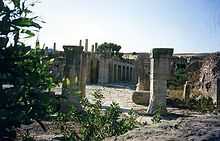Musti (Tunisia)

Musti or Mustis was a city in the Roman province of Proconsular Africa, which is now northern Tunisia. Its ruins, called Mest Henshir, are about eight miles from Dougga.
History
Musti was an important town in the Roman era, located along the Roman road that ran between Carthage and Tebessa. The limits of the town were set in 238 by two triumphal arches, erected on this road which traversed Musti from east to west. Towards the end of 2nd century BC the Roman general Gaius Marius settled his veterans here and at a later time it was elevated to the rank of a municipium by Julius Caesar or by Marcus Aurelius. The ancient Roman town lost its appearance when the Byzantines transformed it into a stronghold during their struggles against the Vandals.
The town has only been partially excavated, leaving a large area still to be researched, but nevertheless boasts remains of the forum, the marketplace, several temples, the cisterns, a Byzantine citadel and a number of Roman houses.
Musti is mentioned by Ptolemy,[1] the Itinerarium Antonini, the Peutinger Table, and the Ravenna geographer, Vibius Sequester, who narrates the killing at this place of an enormous serpent by Regulus. The inscriptions call the inhabitants Musticenses or Mustitani; the latter name is also used by Augustine.[2]
Sights
The triumphal arch located at the entrance of the site is still of unknown attribution. The eastern arch, which was in a very ruined state, was restored in 1967 by the National Institute of Art and Archaeology and the Historical Monuments Service. The nearby Mausoleum of the Julii was also restored at this time. The entire restoration took 17 months to complete.
The entrance of the site opens onto a large paved yard which leads to an attractive gateway. This gate had a covered walkway on the left and on the right. To the sides are the shops of the moneychangers and some bas-reliefs of well wishing genies.
Near the gate are the remains of three temples (to Ceres, Pluto and Apollo). Further on are ruins of a small 4th century Christian church, a basilica with three naves and a raised sacred area (the baptistry). It is adjoined by a large Byzantine fortification.
Ecclesiastical history
There was another Musti in Numidia, which Sophrone Pétridès confuses with the Musti in the Roman province of Proconsular Africa, even to the extent of presenting the supposed single see as represented at the 411 conference at Carthage by four bishops, two Donatist (Felicianus and Cresconius) and two Catholic (Victorianus and Leontius).[2] J. Mesnage distinguishes between the two sees, assigning Felicianus and Victorianus to the Musti of Proconsular Africa, a suffragan of Carthage, and Cresconius and Leontius to what he calls Musti Numidiae.[3] The Catholic Church's list of titular sees also distinguishes between the two, calling one see simply Musti and the other Musti in Numidia.[4] Mesnage also distinguishes between the sees of two other bishops of whom Pétridès speaks as bishops of a single Musti: an Antonianus of the Numidian Musti was one of the bishops whom Huneric exiled in 482, and the Januarius who in 646 signed the letter of the bishops of Proconsular Africa to Paul, Patriarch of Constantinople, against the Monothelites, was obviously of that province.
References
- ↑ IV, 3, 33
- ↑ 2.0 2.1 Sophrone Pétridès, The Catholic Encyclopedia 10, 1911
- ↑ J. Mesnage, L'Afrique chrétienne:Évêchés & ruines antiques (Paris 1912), pp. 118 and 424
- ↑ Annuario Pontificio 2013 (Libreria Editrice Vaticana, 2013, ISBN 978-88-209-9070-1), p. 935
External links
- Lexicorient
- Cassiciaco (Italian)
- Unesco pdf-file (French document)
-
 "Musti". Catholic Encyclopedia. New York: Robert Appleton Company. 1913.
"Musti". Catholic Encyclopedia. New York: Robert Appleton Company. 1913. - Pius Bonifacius Gams, Series episcoporum Ecclesiae Catholicae, Leipzig 1931, p. 467
- Stefano Antonio Morcelli, Africa christiana, Volume I, Brescia 1816, p. 236
- J. Mesnage, L'Afrique chrétienne, Paris 1912, p. 424